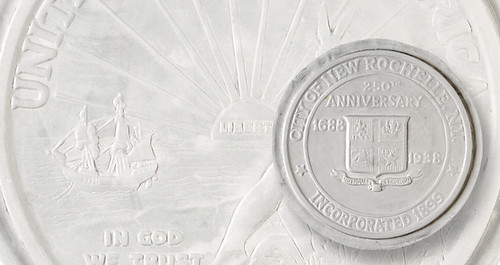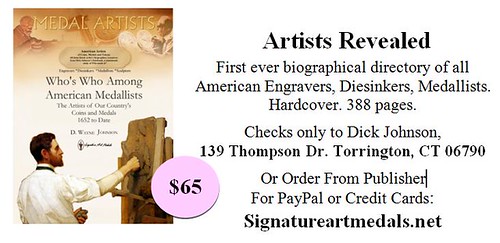
PREV ARTICLE
NEXT ARTICLE
FULL ISSUE
PREV FULL ISSUE
HANDLING AND PRESERVING PLASTER COIN MODELS
There's a special place in my collecting heart for plaster coin models. These unique (or nearly so) items are an integral part of the
coin creation process, as close as one can usually get to the artist's original work. But collecting them is not for the faint of
heart. They are bulky and difficult to store and display, and also fragile and easily dirtied or damaged. Susan Maltby published a nice
article in Coin World November 12, 2015 about handling and preserving plaster collectibles. -Editor

Many numismatists have plaster objects in their collections, whether they be a cast of a coin, an artist’s rendition or a limited edition reproduction of an artist’s original work. Plaster is a form of calcium sulfate. It is made by heating gypsum rock to remove its water, which creates calcium sulfate hemihydrate. This is then ground into a powder, commonly known as plaster of paris. The powder is then mixed with water so it can be sculptured or cast in a mold. Plaster sets up — or dries — through a chemical reaction. This reaction is exothermic, meaning it gives off heat as it takes place. Depending on the volume of plaster being used, the amount of heat generated can be considerable. Artists commonly use plaster as a medium because it can replicate fine detail when cast and because it shrinks very little when it dries, unlike clay and other materials used in modeling. Its low cost also has made it appealing. Small plaster casts, such as those found in numismatic collections, are likely solid. Although plaster is commonly left “raw,” it can also be sealed with a clear sealant or decorated with paint and pigments. Plaster is brittle and fragile. It will break if dropped or knocked hard enough. Plaster pieces should be displayed so that they are safely out of harm’s way. Handle plaster pieces with great care. If packing for shipping, make sure that the object is well padded and packed so that it cannot move around inside the box. Plaster is also fairly soft and will scratch easily. Humidity/moisture is a big concern with plaster. Plaster is slightly soluble in water and prolonged exposure to high humidity will cause the plaster to disintegrate. Plaster is sensitive to acids. As such, any materials in intimate contact with it should be acid-free and inert, similar to what is recommended for metal coins tokens or medals. Plaster is porous and, if unsealed, will soil easily, absorbing dirt and grime. Once soiled, it is very difficult to clean without adversely affecting the surface of the plaster. Preventing soiling is the best approach. Handle plaster objects with clean dry hands. Store in an archival-quality box. Exhibiting plaster objects in a display case or behind glass will help keep them from getting soiled. If a plaster objects becomes dusty, remove the dust carefully with a soft brush or a clean dusting cloth. Do not use water to clean plaster objects. Water can dissolve the plaster and will drive any dirt into the plaster, making it even harder to clean. Abrasive techniques, such as erasers, are not recommended as they can cause the surface of the plaster to become burnished, changing its appearance. To read the complete article, see:

Wayne Homren, Editor The Numismatic Bibliomania Society is a non-profit organization promoting numismatic literature. See our web site at coinbooks.org. To submit items for publication in The E-Sylum, write to the Editor at this address: whomren@gmail.com To subscribe go to: https://my.binhost.com/lists/listinfo/esylum All Rights Reserved. NBS Home Page Contact the NBS webmaster 
|